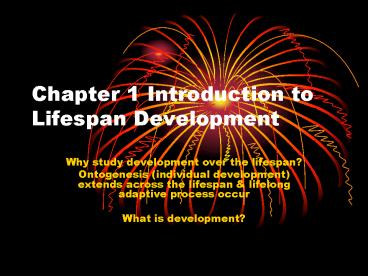Chapter 1 Introduction to Lifespan Development - PowerPoint PPT Presentation
1 / 26
Title:
Chapter 1 Introduction to Lifespan Development
Description:
Ontogenesis (individual development) extends across the lifespan & lifelong ... Timing of the life event influences future development ... – PowerPoint PPT presentation
Number of Views:1146
Avg rating:3.0/5.0
Title: Chapter 1 Introduction to Lifespan Development
1
Chapter 1 Introduction to Lifespan Development
- Why study development over the lifespan?
- Ontogenesis (individual development) extends
across the lifespan lifelong adaptive process
occur - What is development?
2
What is development?
- Age alone does not explain it.
- It is discontinuous as well as continuous.
- Timing of the life event influences future
development - Behaviors may change in form but result from the
same process. Ex. Attention in infancyadult
problem solving - Examine cause and effect relationships
3
(No Transcript)
4
Why study lifespan?
- An organized view of development
- Cite interconnections between lifes early and
late stages/events - Name mechanisms influencing development
- Specify variables, biological, psychological,
environmental that shape development
5
Characteristics of lifespan development
6
Characteristics of lifespan development
- A lifelong process
- Multidirectional both gain loss
- Selectionchoosing food
- Plasticityimproving memory by training
7
Define
- Inter-individual differencesbetween individuals
- Intra-individual differencespotential for change
within an individual
8
Developmental periods
- Prenatal
- conception to birth
- Infancy 0-2
- Early childhood
- 2-6
- Middle childhood 7-11
- Adolescence
- 12-18
- Early adulthood 19-34
- Middle adulthood 35-64
- Later adulthood
- 65
9
Define
- Reciprocal interactions similar to a
transactional model the childs active role in
change and personal development. Ex. The adult
stimulates the child, the child changes, and as a
result of changes in the child, the adult changes
10
Two Perspectives of Development
- Biological
- Environmental
11
Michael Rutter (2002)
- Interaction of biological, psychological and
social influences is more definitive than just
genes - Challenge discover how genetic influences and
brain functions are altered by experience
12
Bioecological perspective definitions
- Reciprocal interactions similar to
transactional model recognizes the childs
active role in personal development - Bioecological model The belief that the
interactions between an individual and the
environment are explained by a system analysis.
(Bronfenbrenner, 1978, 1979, et.al.)
13
More definitions
- Proximal processes Bronfenbrenners term for
the reciprocal interactions between a person and
the environment. Context development. Ex.
Feeding/playing with a child teacher
interactions with a child. . . (level 1)
14
Bronfenbrenners 3 other structures
- Microsystem deepest level, home or school are
examples (level 2) - Mesosystem refers to the relationships between
microsystems, i.e., family expectations influence
school achievement (3rd level)
15
Bronfenbrenners level 4
- Macrosystem the blueprint for any society, the
master plan for human development in a society
16
Chronosystem
- These systems are not isolated from one another
and they interact over time. Discuss the impact
of a father losing his job and having to move
17
More definitions
- Microsystem the home or school
- Mesosystem the relationship among microsystems
- Exosystem an environment in which a person is
not active but affects development. Ex. Behavior
of other parents impacts the relationship of a
child with his/her own parents
18
Biopsychosocial interactions
- Development proceeds through the interaction of
biological, environmental, and psychological
forces, i.e., genetic, physical, behavioral,
environmental across cross-cultural and
sociocultural issues
19
Significance of culture in development
- Superficial facts that make up an individuals
history - Intermediate social development culturally
cultural behaviors that are at the core of a
childs life, language is a good example. - Significant level grasp the values, beliefs, and
norms that structure a persons world
20
Issues in Lifespan Development
- Continuity development proceeds steadily and
sequentially - Vs.
- Discontinuity abrupt changes and stages
21
Stability
- Early experiences affect children for life
- Vs. change is likely
22
Nature vs. Nuture issue
23
Developmental research HOW??
- 4 time variable studies
- one time, one group
- longitudinal
- cross-sectional
- sequential studies (a combo)
24
3 data collection techniques
- Descriptive studiesuse interviews or
questionnaires - Manipulative experimentschange only one variable
- Naturalistic experimentsresearcher is an
observer and does not interact it is possible to
discover cause and effect in real life
25
4 parts of a research article
- Introduction/review of the literature
- Method
- Results
- Discussion/conclusion/
- recommendations for future studies
26
Chapter quiz






![[PDF] Introduction to Critical Care Nursing 8th Edition Free PowerPoint PPT Presentation](https://s3.amazonaws.com/images.powershow.com/10079332.th0.jpg?_=20240716074)
























